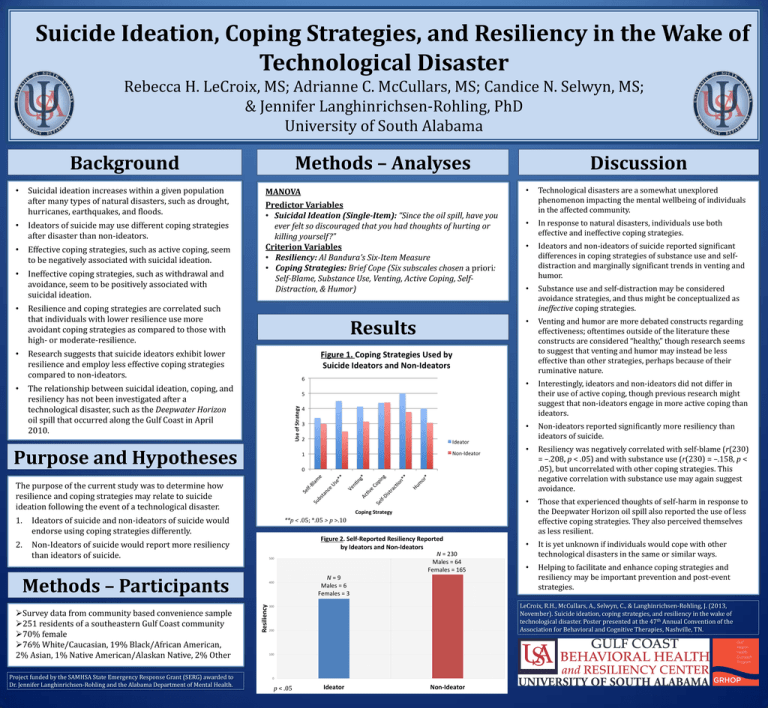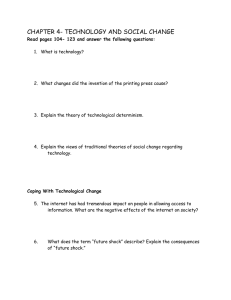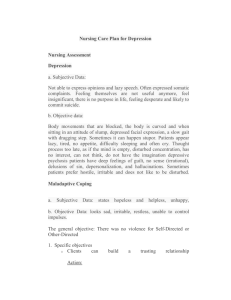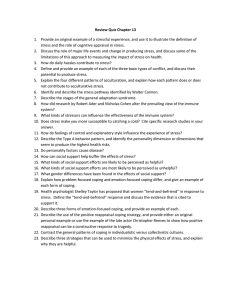Suicide Ideation, Coping Strategies, and Resiliency in the Wake of
advertisement

Suicide Ideation, Coping Strategies, and Resiliency in the Wake of Technological Disaster Rebecca H. LeCroix, MS; Adrianne C. McCullars, MS; Candice N. Selwyn, MS; & Jennifer Langhinrichsen-Rohling, PhD University of South Alabama Background Suicidal ideation increases within a given population after many types of natural disasters, such as drought, hurricanes, earthquakes, and floods. • Ideators of suicide may use different coping strategies after disaster than non-ideators. • • Effective coping strategies, such as active coping, seem to be negatively associated with suicidal ideation. • Ineffective coping strategies, such as withdrawal and avoidance, seem to be positively associated with suicidal ideation. Methods – Analyses MANOVA Predictor Variables • Suicidal Ideation (Single-Item): “Since the oil spill, have you ever felt so discouraged that you had thoughts of hurting or killing yourself?” Criterion Variables • Resiliency: Al Bandura’s Six-Item Measure • Coping Strategies: Brief Cope (Six subscales chosen a priori: Self-Blame, Substance Use, Venting, Active Coping, SelfDistraction, & Humor) Resilience and coping strategies are correlated such that individuals with lower resilience use more avoidant coping strategies as compared to those with high- or moderate-resilience. • Results Research suggests that suicide ideators exhibit lower resilience and employ less effective coping strategies compared to non-ideators. • The relationship between suicidal ideation, coping, and resiliency has not been investigated after a technological disaster, such as the Deepwater Horizon oil spill that occurred along the Gulf Coast in April 2010. • Purpose and Hypotheses The purpose of the current study was to determine how resilience and coping strategies may relate to suicide ideation following the event of a technological disaster. 1. 2. Ideators of suicide and non-ideators of suicide would endorse using coping strategies differently. 500 Methods – Participants Project funded by the SAMHSA State Emergency Response Grant (SERG) awarded to Dr. Jennifer Langhinrichsen-Rohling and the Alabama Department of Mental Health. • Technological disasters are a somewhat unexplored phenomenon impacting the mental wellbeing of individuals in the affected community. • In response to natural disasters, individuals use both effective and ineffective coping strategies. • Ideators and non-ideators of suicide reported significant differences in coping strategies of substance use and selfdistraction and marginally significant trends in venting and humor. • Substance use and self-distraction may be considered avoidance strategies, and thus might be conceptualized as ineffective coping strategies. • Venting and humor are more debated constructs regarding effectiveness; oftentimes outside of the literature these constructs are considered “healthy,” though research seems to suggest that venting and humor may instead be less effective than other strategies, perhaps because of their ruminative nature. • Interestingly, ideators and non-ideators did not differ in their use of active coping, though previous research might suggest that non-ideators engage in more active coping than ideators. • Non-ideators reported significantly more resiliency than ideators of suicide. • Resiliency was negatively correlated with self-blame (r(230) = –.208, p < .05) and with substance use (r(230) = –.158, p < .05), but uncorrelated with other coping strategies. This negative correlation with substance use may again suggest avoidance. • Those that experienced thoughts of self-harm in response to the Deepwater Horizon oil spill also reported the use of less effective coping strategies. They also perceived themselves as less resilient. • It is yet unknown if individuals would cope with other technological disasters in the same or similar ways. • Helping to facilitate and enhance coping strategies and resiliency may be important prevention and post-event strategies. **p < .05; *.05 > p >.10 Non-Ideators of suicide would report more resiliency than ideators of suicide. 400 Resiliency Survey data from community based convenience sample 251 residents of a southeastern Gulf Coast community 70% female 76% White/Caucasian, 19% Black/African American, 2% Asian, 1% Native American/Alaskan Native, 2% Other Discussion Figure 2. Self-Reported Resiliency Reported by Ideators and Non-Ideators N = 230 Males = 64 Females = 165 N=9 Males = 6 Females = 3 LeCroix, R.H., McCullars, A., Selwyn, C., & Langhinrichsen-Rohling, J. (2013, November). Suicide ideation, coping strategies, and resiliency in the wake of technological disaster. Poster presented at the 47th Annual Convention of the Association for Behavioral and Cognitive Therapies, Nashville, TN. 300 200 100 0 p < .05 Ideator Non-Ideator





